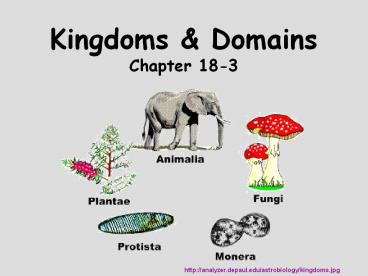Kingdoms PowerPoint PPT Presentation
Title: Kingdoms
1
Kingdoms DomainsChapter 18-3
http//analyzer.depaul.edu/astrobiology/kingdoms.j
pg
2
As we discovered more about the natural world
- not all organisms fit into Linnaeuss 2 kingdoms
(_____ or _____)
plant
animal
fungi
bacteria
Ex _________ _____
Images from http//www.leighday.co.uk/upload/pu
blic/docImages/6/Listeria20bacteria.jpg
http//danny.oz.au/travel/iceland/p/3571-fungi.jpg
3
FIVE ORIGINAL KINGDOMS
_______________________
(BACTERIA)
http//analyzer.depaul.edu/astrobiology/kingdoms.j
pg
4
As we learned more about bacteria, the __________
kingdom was split into TWO distinct kingdoms
___________ ______________
MONERA
Eubacteria Archaebacteria
6 KINGDOMS used today
Eubacteria
Archaebacteria
Protista
Plantae
Fungi
Animalia
5
THREE-DOMAIN system
- Molecular analyses have given
- rise to a ___________
- _______ now recognized
- _______
new taxonomic
category
DOMAIN
6
Bacteria
Archaea
Eukarya
Eubacteria
Archaebacteria
Protista
Plantae
Fungi
Animalia
Domains are larger than Kingdoms and are based
on the kind of ____________ an organism has.
Ribosomal RNA
7
6 Kingdom System
Animalia
Plantae
Fungi
Protista
Eubacteria
Archaebacteria
Kidspiration by Riedell
8
- REMEMBER
Cell without a nucleus ____________(Includes
bacteria) Cell with a nucleus and organelles
surrounded by membranes _________________
(includes plants and animals) Organism that can
make its own food using photosynthesis or
chemosynthesis ______________ Organism that
gets food energy from consuming other organisms
_____________
PROKARYOTE
EUKARYOTE
AUTOTROPH
HETEROTROPH
9
- REMEMBER
A ONE-CELLED organism _____________________ O
rganism made of many cells ______________ Polys
accharide made by joining glucose molecules
together which makes plants sturdy
_________________
UNICELLULAR
MULTICELLULAR
CELLULOSE
http//bioweb.wku.edu/courses/Biol115/Wyatt/defaul
t.htm
10
DOMAIN BACTERIAKINGDOM EUBACTERIA
- _______________________
- ______________________
- Have cell walls with ________________
- Can be ____________ or ______________
- EXAMPLES _____________________
PROKARYOTES
UNICELLULAR
PEPTIDOGLYCAN
AUTOTROPHS HETEROTROPHS
E. coli, Streptococcus
http//chemiris.chem.binghamton.edu/ZHONG/research
/bacteria3.jpg
11
Polymer made of sugars and amino acids found
outside the cell membrane in the cell wall in
some bacteria ______________
PEPTIDOGLYCAN
http//www.scq.ubc.ca/?p481
12
DOMAIN ARCHAEAKINGDOM ARCHAEBACTERIA
PROKARYOTES
- _________________
- _________________
- Have cell walls
- _________ peptidoglycan
- Can be ___________ or ______________
- EXAMPLES _____________________
- LIVE IN EXTREME ENVIRONMENTS like volcanic hot
springs, brine pools, low oxygen
UNICELLULAR
WITHOUT
AUTOTROPHS HETEROTROPHS
Halophiles thermophiles
13
http//www.teara.govt.nz/NR/rdonlyres/737B7002-C31
D-418D-84C5-D0E68ED87BBB/134228/hero6483.jpg
- Organisms that can live in HIGH temperature
environments - ________________
- Organisms that can live in high salt environments
- ______________
THERMOPHILES
HALOPHILES
http//web0.greatbasin.net/wigand/petespaleo/Colu
mbus20Salt20Marsh.jpg
14
DOMAIN EUKARYAKINGDOM PLANTAE
- _______________________
- ______________________
- Have cell walls with ________________
- and _____________
- _________________
- EXAMPLES _____________________
EUKARYOTES
MULTICELLULAR
CELLULOSE
CHLOROPLASTS
AUTOTROPHS
Mosses, ferns, trees, flowering plants
http//www.russianflora.com/store/images/product/c
ustom_green_plant_35.jpg
15
DOMAIN EUKARYAKINGDOM ANIMALIA
http//www.millan.net
- _______________________
- _____________________
- ________________ or _______________
- __________________
- EXAMPLES _____________________
EUKARYOTES
MULTICELLULAR
NO CELL WALLS CHLOROPLASTS
HETEROTROPHS
Worms, insects, fish, birds, mammals, humans
16
DOMAIN EUKARYAKINGDOM FUNGI
- _______________________
- ______________________
- Have cell walls with ________________
- _______________
- __________________________________
- _______________________
- EXAMPLES _____________________
EUKARYOTES
Most MULTICELLULAR few UNICELLULAR
CHITIN
HETEROTROPHS- absorb nutrients from decaying
organic matter
Mushrooms, yeast
http//www.ontarionature.org/home/images/mushrooms
.jpg
17
DOMAIN EUKARYAKINGDOM PROTISTA
- _______________________
- ______________________
- Some have cell walls with ________________
- ____________________
- Can be _____________ or _____________
- EXAMPLES _____________________
EUKARYOTES
Most UNICELLULAR some colonial/multi
CELLULOSE
Some have chloroplasts
AUTOTROPHS HETEROTROPHS
Amoeba Paramecium Giant kelp slime mold
http//www.ravelgrane.com/pix/proj/draco/parameciu
m-nahrung.gif
18
Figure 18-12 Key Characteristics of Kingdoms and
Domains
Section 18-3
Classification of Living Things
DOMAIN KINGDOM CELL TYPE CELL
STRUCTURES NUMBER OF CELLS MODE OF
NUTRITION EXAMPLES
Bacteria ____________ Prokaryote Cell walls
with peptidoglycan Unicellular Autotroph
or heterotroph Streptococcus, Escherichia coli
Archaea Archaebacteria Prokaryote Cell walls
without peptidoglycan _____________ Autotro
ph or heterotroph Methanogens, halophiles
Protista Eukaryote Cell walls of cellulose in
some some have chloroplasts Most unicellular
some colonial some multicellular _______________
___________ Amoeba, Paramecium, slime molds,
giant kelp
Fungi Eukaryote ______________________ Mo
st multicellular some unicellular Heterotroph
Mushrooms, yeasts
Plantae Eukaryote Cell walls of cellulose
chloroplasts ___________ ___________ Mos
ses, ferns, flowering plants
Animalia ____________ No cell walls or
chloroplasts ____________ ____________
Sponges, worms, insects, fishes, mammals
Eukarya
Eubacteria
Eukaryote
Cell walls of chitin
Multicellular
Multicellular
Unicellular
Autotroph or Heterotroph
Autotroph
Heterotroph
19
Figure 18-13 Cladogram of Six Kingdoms and Three
Domains
Section 18-3
DOMAIN ARCHAEA
DOMAIN EUKARYA
Kingdoms
Eubacteria Archaebacteria Protista Plantae Fungi A
nimalia
DOMAIN BACTERIA

